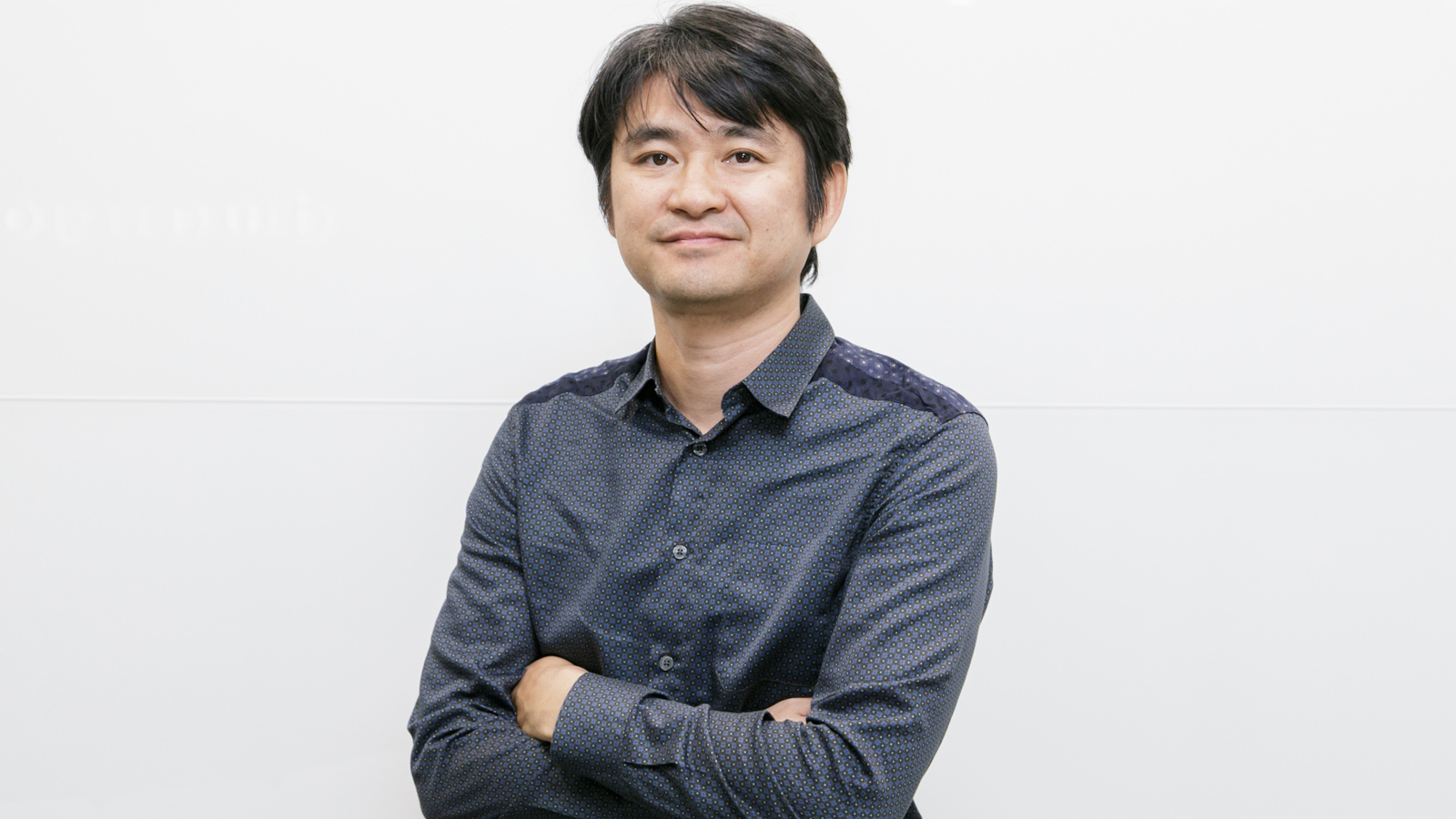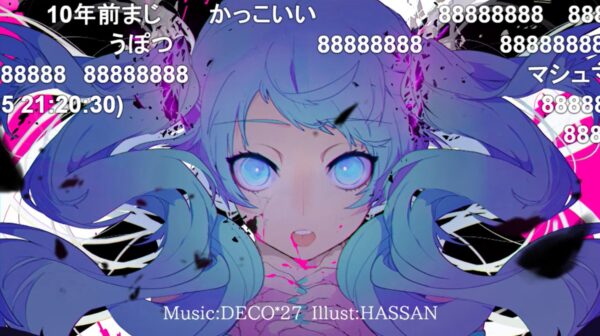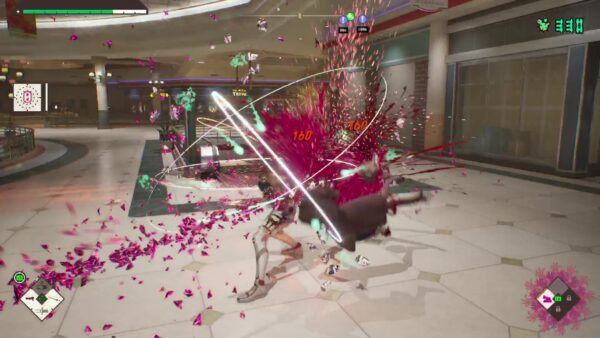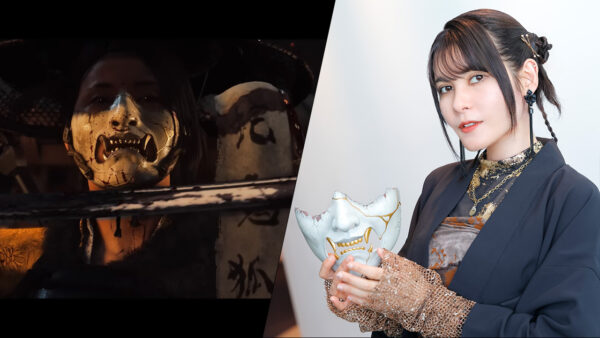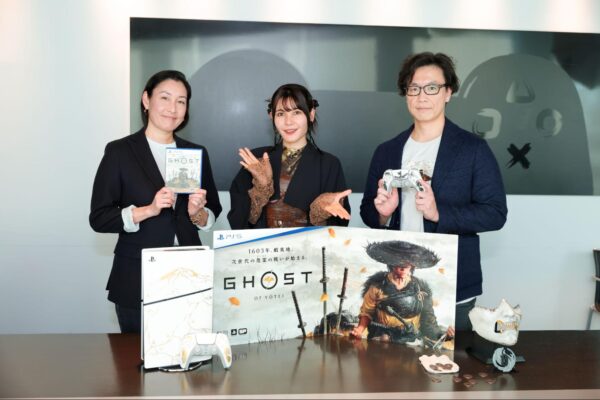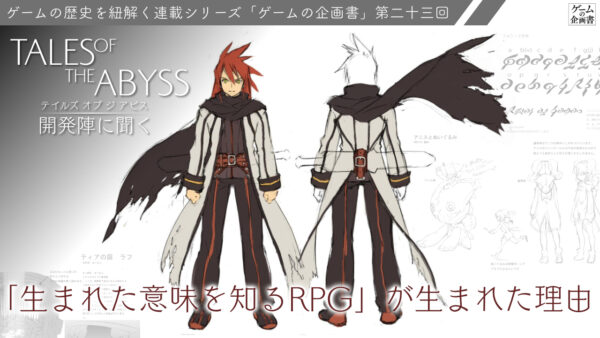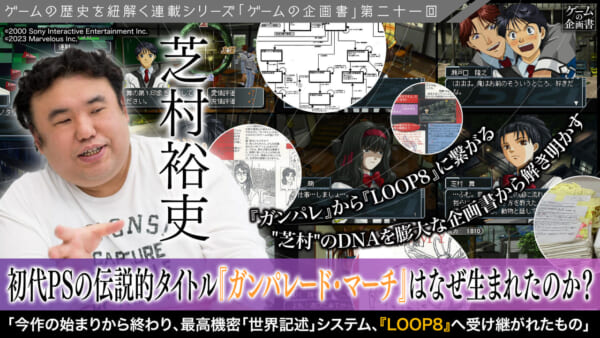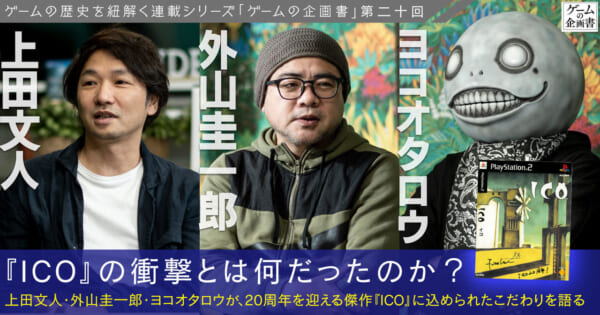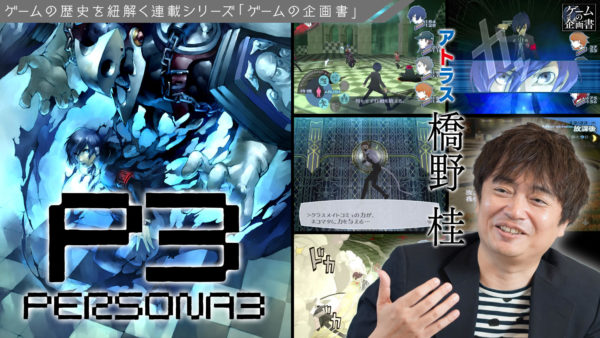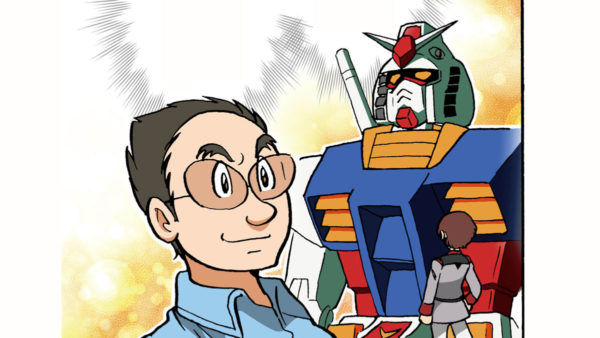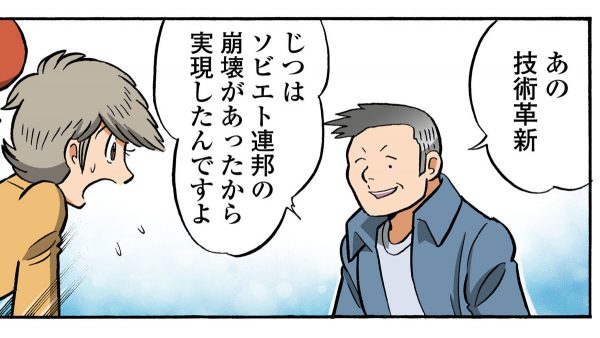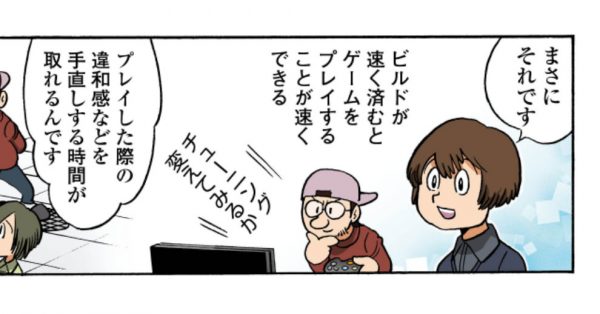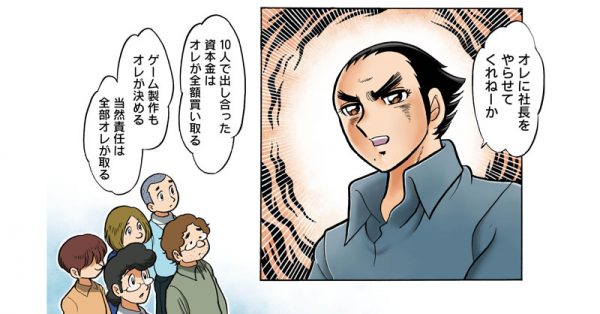What is the appeal of digital games?
Shimizu:
Because when Mr. Mizuguchi was playing earlier, he would play around flying during the scene with the ending credits. I thought that the elements of battle were a little excessive half-way through playing the game. Of course, even with that, I think it’s amazing that it excites people this much.
— The strangest part of “Area X” is how there are no particular completion benefits but there’s this mysterious sense of achievement when you make it to the end. I feel like it’s an excitement that’s born from the structure of the game. I doubt this could be achieved without certain parts of the game.
Mizuguchi:
In “Area X,” there is a “traveling” mode where there’s no game over, and a normal mode with a game over. In my mind, I thought it would be ok with just the “traveling” mode. But there are still people who seek a sense of accomplishment …
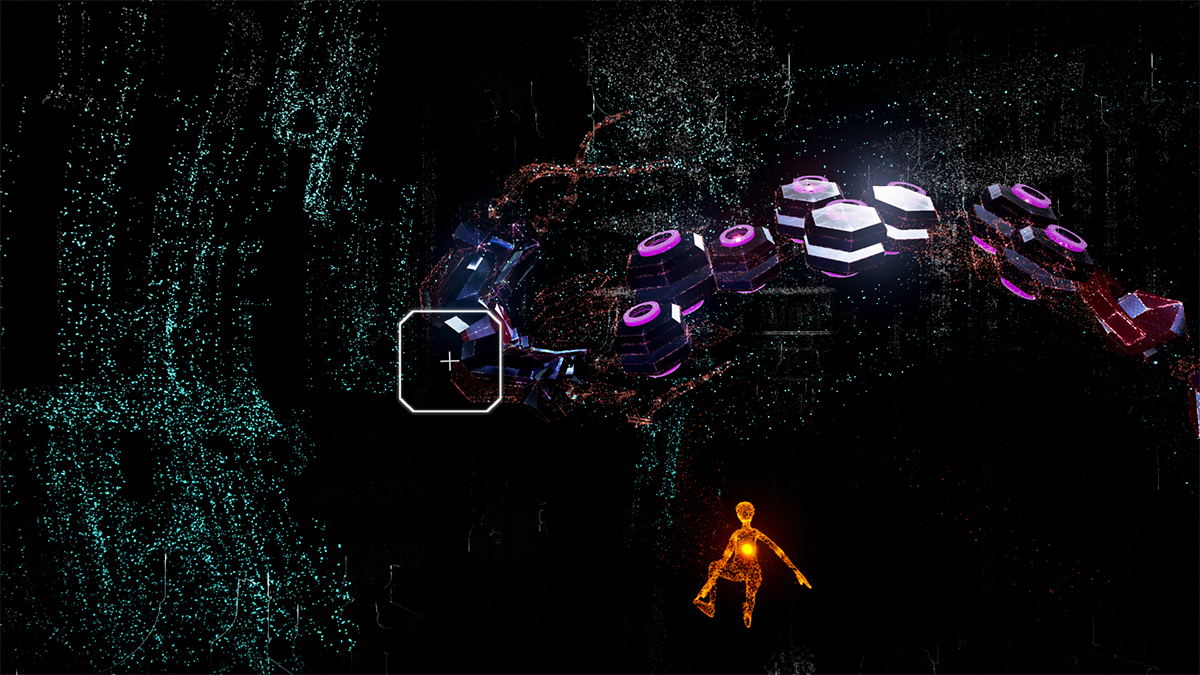 |
So, eventually, we added an efficiency indicator and used the minimum qualities needed to make it “video game-like”.
— But, in fact, almost everyone, including me, is using the “traveling” mode. And we’re not casual gamers, either. Even those who usually compete for scores and achievements on their smartphones or non-portable devices are playing in this mode, which I think is significant.
Shimizu:
It’s a question of whether a video game with”no game over” applies to the definition of video games we’ve created. For me, the most important thing in Mr. Mizuguchi ‘s work is interaction, so I don’t think there’s any need to be “video game-like” in that sense.
— If that’s the case, I’m wondering what Mr. Mizuguchi interprets as the appeal in digital games.
Mizuguchi:
Well … there are a couple of things, but first is a “sense of accomplishment.” This is the essential structure to the game. It’s something that has continued from the analog age and doesn’t particularly require a high “resolution” of expressions.
However, what matters most to me is an element of “sensual and physiological pleasantness.” For example, in a music video by Michael Jackson, dancers who had been moving separately, suddenly come together. You get goose bumps, you know? Elegance from moments when multiple elements synchronize is a typical example, but in digital games, you can further intensify this feeling. I think “Rez” is close to that.
— I see. So, how does VR involve such basic appeal?
Mizuguchi:
To put it bluntly, VR has a great “immersiveness.” Because you enter that world.
Until now, there was a world on the other side of the display, and it was like peering through a “window.” That’s maybe why, rather than “physiologically pleasant” or an “immersive feeling,” games have been designed with a greater weight of “sense of accomplishment.”
—I just remembered with that, but when listening to early designer’s stories in this series, there are many talented people who stood out from the “sense of accomplishment” aspect of game design. However, after CG arrived, the designers’ style has been clearly changing. The number of directors who were once designers has increased and more people are aiming for a complete work of art that’s cinematic with strong story lines. If anything, the early designers seem to be taking a step back from the front lines.
Mizuguchi:
But in a world like media art, there’s always been a strong expression of sensation and physiology. How do I say this … There are expressions and experiences that humans are moved by without having to use words. That’s where the true identity of “sensually pleasant” exists, but if the “resolution” is low, it’s hard to “immerse” in.
— The “resolution” you’re talking about here is probably a “metaphorical phrase” and not the usual meaning, like for a screen display. There’s an impression that media art people often use the word, but is it like, “how accurately can media express the author’s intended expression?” For example, rather than flat displays, can stereoscopic displays and VRs reproduce the artist’s image more accurately, right?
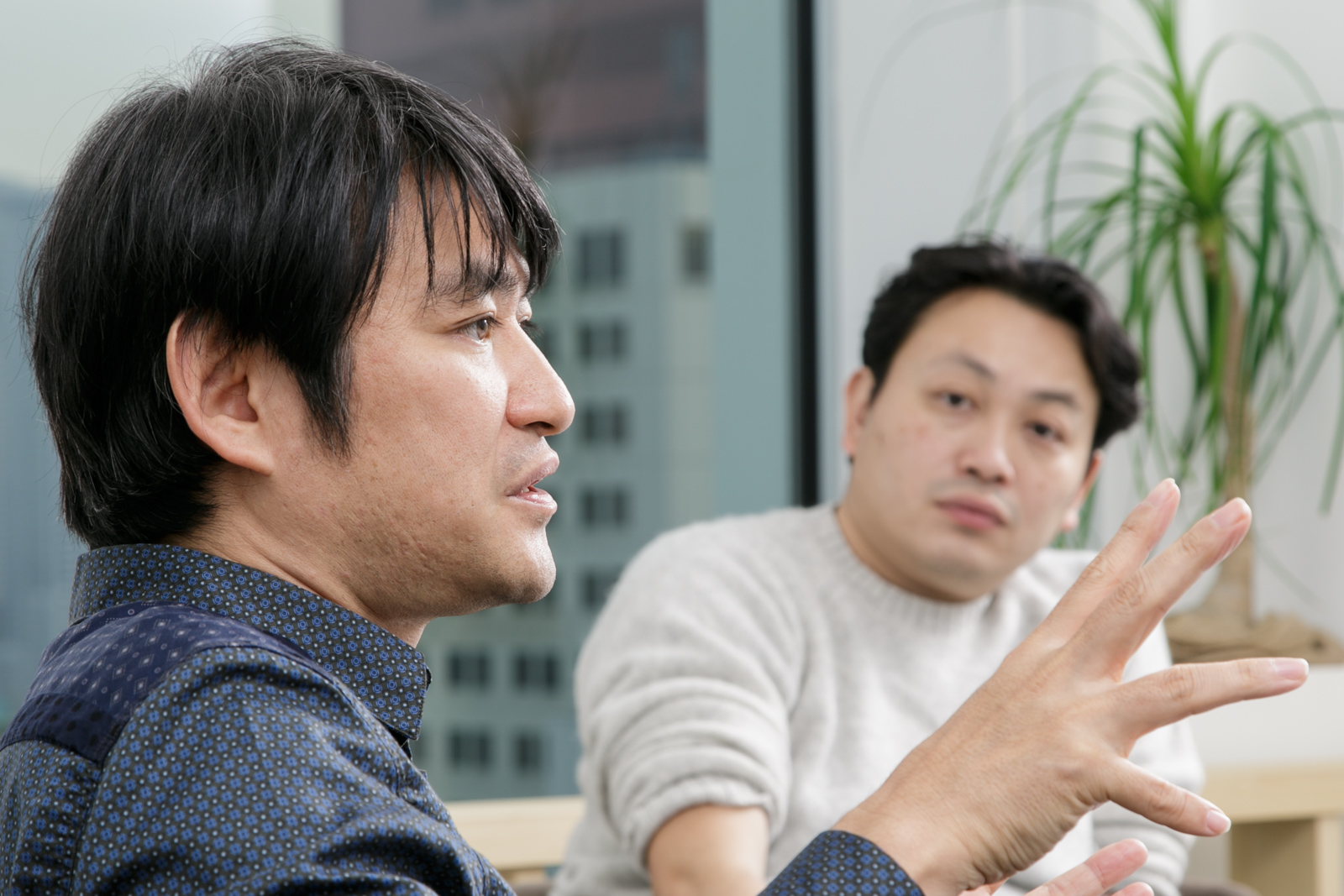 |
Mizuguchi:
Yes Yes.
— In that sense, I certainly think that our previous expressions were trapped in the region of “low resolution.” And then, when the “resolution” of expression increases with VR, there is potential that the predominate point in video games will change greatly, like how cinematic storytelling gained power with 3D polygons. In fact, during our horror feature, there was a story from Keiichiro Toyama [*] that VRs are occupying a larger weight of traditional horror works. The player can be suddenly surprised since there’s no longer a need to gain the player’s empathy.
*Keiichiro Toyama
A Japanese game designer born in 1978. Handled works including “Silent Hill” “Siren” and “Gravity Rush.” Considered as one of the leaders of survival horror video games.
Shimizu:
But, if f I add one thing that hasn’t received much attention, “Rez” is actually from a third person viewpoint.
— Definitely. There are avatars.
Shimizu:
I think Mr. Mizuguchi is using the avatar as a point for emotional involvement, which doesn’t exist elsewhere, right?
 |
And placing an empathetic object in this environment is a really SEGA idea. Of course, TPS games place the character inside the screen, but the level design in those past games don’t allow for first-person.
However, Mr. Mizuguchi didn’t even hesitate to use that idea with VR. This is a tremendous thing and I believe, actually, an invention. Because normally you think, “All right, with VR, the age of first-person video games is gonna come!”
Mizuguchi:
Actually, in the “Child Of Eden,” [*] which is like a spiritual sequel of “Rez,” I already experienced creating first person games. First person is difficult in the placement of the existence of self. We debated for awhile, but decided to value the feeling in the original “Rez” in “Area X.”
*Child Of Eden
A shooter game released in 2011, exclusive to Xbox 360 as well as PS3. Compatible with motion controllers, it can also be played with Xbox 360’s Kinect. One of Mr. Mizuguchi’s works.
— Does that mean it’s important to feel the enemies approaching you?
Mizuguchi:
I think it’s easier to say, in that world, there are no “clues” on how to feel yourself. When your body disappears on the screen, there is no reference point for yourself in the first place … … something is missing.
Shimizu:
So, it’s like, if your ‘body’ is not in the screen, the emotional involvement is lost.
As expected, I think that Mr. Mizuguchi’s experiencing developing fir Kinect [*] with “Child Of Eden” is significant. Other games use something like PS Move, but with the experience from developing for Kinect, there was probably a a realization that to play for many hours, controllers are better.
※Kinect
A device that can be operated by gesture and speech recognition released by Microsoft in 2010. News spread quickly about the possibility of playing without using a controller. Playing with movement of the whole body is now referred to as “Kinect,” such as “Kinect Sports.”
Mizuguchi:
That too. And also, that human shape avatar – we call it “man” – but it starts transforming rapidly in the game, you know?
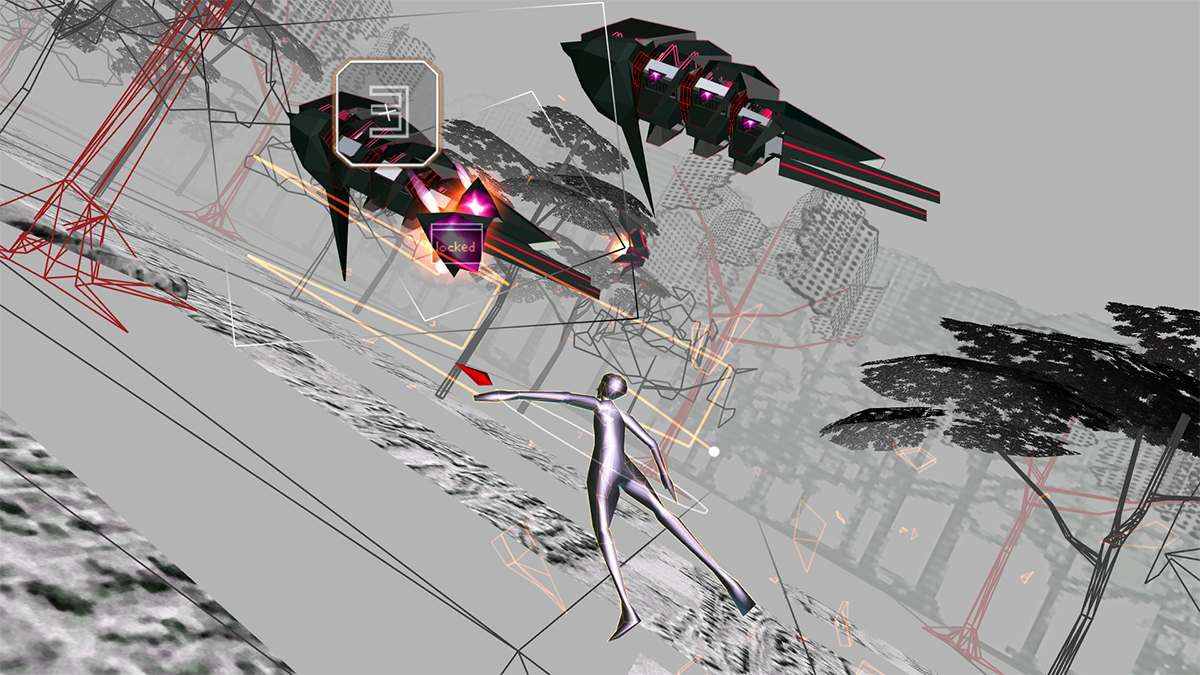 |
“Area X“ purposely reduced the variations of transformation, but in the main part of “Rez,” this light-like ball becomes more and more human-shaped. In the end, after sitting in mediation, it turns into a baby and gradually changes into something like an Astral body[*]. Actually, that itself plays the role of storytelling. It expresses what kind of world view it is and what it is trying to convey.
*Astral body
In the study of theosophy, the third body outside of physical and etheric body. It is regarded as a non-sensory entity presiding over deep consciousness, such as emotions and desires. Also referred to as a desire body, emotion body, sensation body or celestial body.
— I think the current topic seems to be related to the fundamentals of pleasure in digital games. In fact, in first-person games, without a present avatar, the feeling that the screen is responding one-on-one to our maneuvers is weak. And the pleasure from the game seems weak. But normally, we also think that VR’s immersiveness and third-person viewpoint is clearly contradictory. I think that for this choice, “conviction” was necessary.
Mizuguchi:
I didn’t have any doubts from the beginning of development.
Shimizu:
I see. Not everyone can reach that kind of realization (laughs). But this way is definitely easier to play.
 |
Mizuguchi:
Of course, I can’t explain the reasons clearly now …… But if you actually had to swallow all the information from “Area X” in a situation without an avatar, believe that many people would find it unbearable.
— Or rather, panic-stricken. Because it feels like you’re suddenly being thrown into total darkness, and have to face these strange moving creatures with your own breathing body. You can accept it because there is an objective third-person viewpoint.
Mizuguchi:
I think the avatar is like our “amulet.” The existence of something on the screen that’s a proxy for something within us, is like a lifeline that connects us and the the world on the other side.
— But isn’t it possible that it’s just necessary because we are not familiar with VR yet? For example, once we’ve moved on from this first generation, there might be more VRs with a subjective viewpoint.
Mizuguchi:
Hmm, I wonder. Perhaps, this feeling won’t go away in the future.
— Although the current VR contains only vision and auditory sense, in reality, human beings draw on all five senses to understand the surrounding environment. The room temperature felt by touch, the odor perceived by sense of smell, etc. is still working, which creates a distortion. So doesn’t it feel like to distract our other senses, there’s a need to “trick” it by compensating with becoming emotionally involved with the avatar…?
Shimizu:
Hmm. No, I think’s it’s a very simple story.
The point is, for instance, if you turn “Space Channel” into VR and you can’t see Ulala anymore because we’re moving in the first person, it’s not fun at all anymore, right?
— Haha. It’s like “There’s no point if I’m the one dancing.” (laughs).
Shimizu:
Because for us, by having Ulala dance, we unite with her and embody her inside our head. With first person, I don’t think that can happen. Well, even if just for the sake of experimenting with this hypothesis, I actually want to try maneuvering the Ulala avatar with my own body. Mr. Mizuguchi, please make ”Space Channel” into VR (haha).
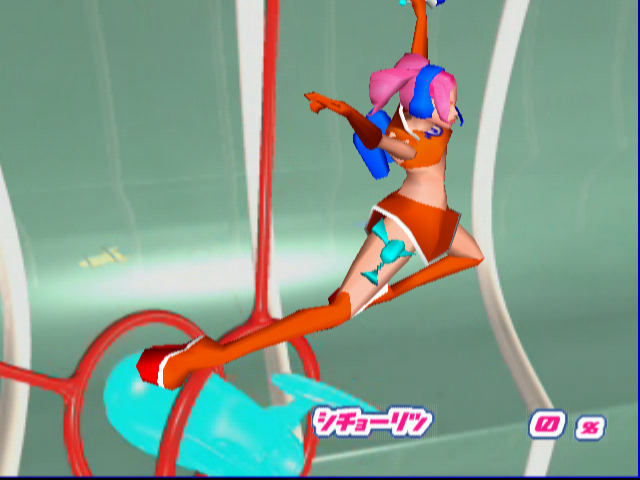
Mizuguchi:
There are probably new rhetoric in VR that aren’t out in the open. It’s not a simple story, like “VR is a subjective media, so subjectivity is the most natural.” Although I am manipulating Ulala objectively, I feel like there is still some way to be personally affected … Well, I’d like to explore it more slowly at some point. But I’m sad I don’t have a buddy to discuss this kind of stuff [with]… (laughs).
Shimizu:
Well, yeah, of course (wry laugh). By the way, I am really almost at my time limit!
— I’m so sorry and thank you very much!
Shimizu:
I’m going home! But I’m reluctant. Mr. Mizuguchi, let’s go drinking together again. I’d like to talk more with you.
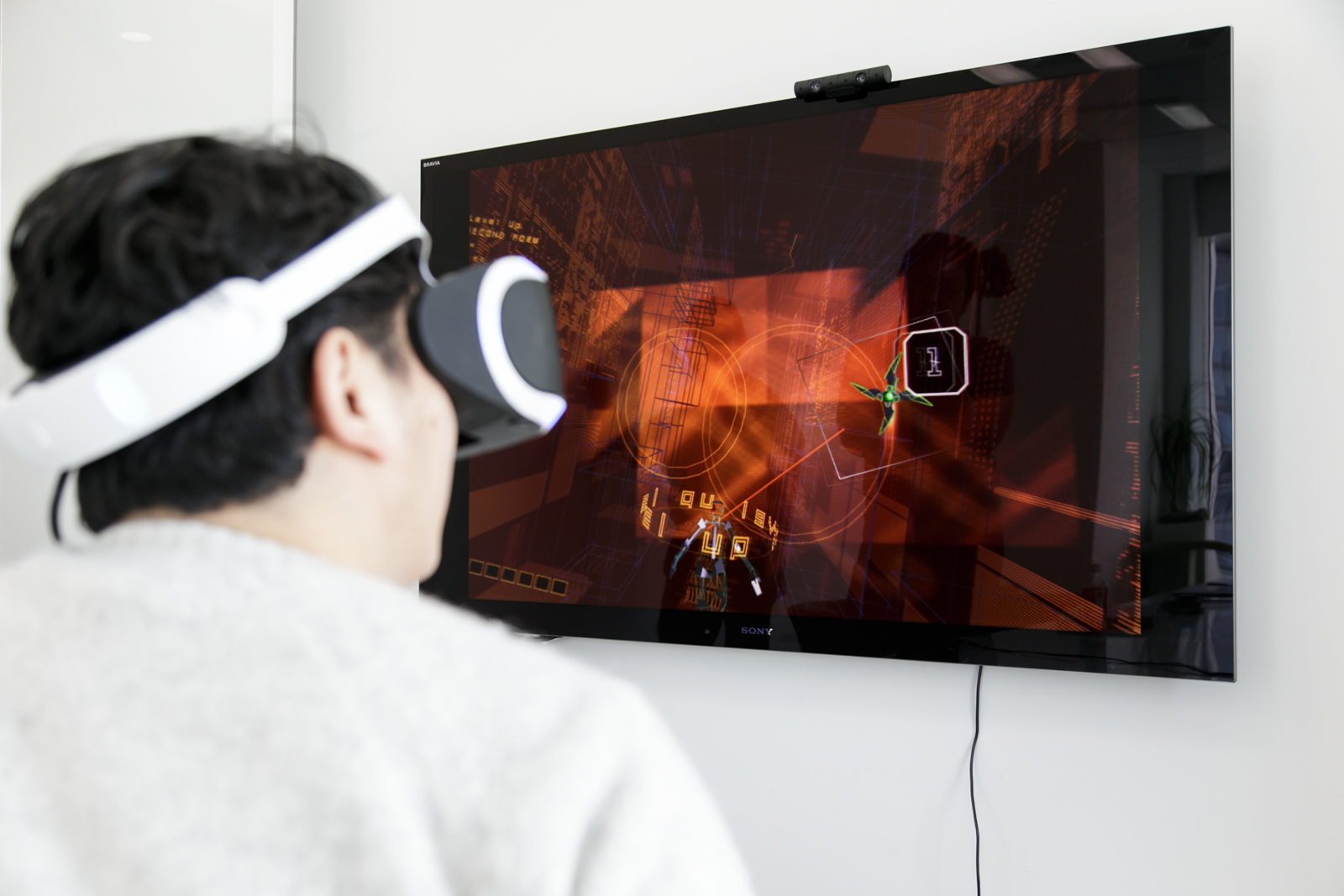
The Development Process of Rez
— Now to regroup, I would like to ask Mr. Mizuguchi about the production process of “Rez”. So, “Rez” is probably one of the strangest video games that stands out in game history. First off, I want to know where this idea suddenly came from.
Mizuguchi:
In the beginning, there was this vague concept of “synesthesia.” For example, like the MTV music videos we just talked about, I imagined that pleasant moment when audio and visual connect.
Long ago, when I would skip class to play “Xevious,” there was something about the sound effects from the shooting that sounded like music. And I would daydream, “I wonder if just these sounds could become a performance.”
— While skipping school (laughs). That’s a good story.
Mizuguchi:
After that, I encountered Amiga’s game called “Zenon 2” and I was really excited about the combination of hip-hop music with shooting games. The hip-hop music was only used as a BGM, but I imagined there was a way it could be integrated more interactively with the gameplay.

(Image is from Mail order shop Surugaya)
— In other words, Mr. Mizuguchi’s gamer… well, maybe not to that extent … but the accumulation of gaming experiences around that age, grew into “a game I’d like to play someday.”
Mizuguchi:
So, this “synchronizing” dream, it always exists within my mind.
Also, while we were producing “Rez,” the staff and I watched this video my friend shot in Kenya numerous times.
In this video, people are eating a meal at an outside bar on the roadside ….when suddenly, one person starts banging his dish, “bang,bang,bang,” then another begins shaking his bottle, “shake,shake,shake.” Everybody ‘s body gradually sways, clapping begins, then standing up, and before you know it, the whole crowd is dancing. Finally, everyone is singing, too.
— That must be a terrific sight.
Mizuguchi:
In only a matter of minutes, from complete silence, a fantastic groove is born. “What on earth is the process of this human chemistry?” — I repeatedly watched the video over and over again. If I could design a game with this chemistry at the core, I was certain I could create a new experience.
— Nonetheless, it seems quite difficult to explain that “certainty” to the staff involved in development.
Mizuguchi:
Yeah, it was difficult.
 |
Moreover, in the game development, there’s a practice where first, it’s decided right away “we’re going to make something like this!” and then things are either broken down or found by exploring various methodologies. With “Rez,” we could only take the latter way. It’s most suitable for creating a truly new experience, but it stressed the staff out.
I also talked about the example of “Xevious” and “Xenon 2″ just before, but it was hard for everyone to understand at first. It was like pulling everyone in while convincing them that “there’s definitely something here, but first let’s experiment.”
— That part must have really been ‘lonely.’ On the other hand, as Mr. Shimizu said earlier, it makes sense there would be rumors that Mr. Mizuguchi is absurd(laughs).
Mizuguchi:
At any rate, I felt confident without evidence (laughs).
First, we began experimentally creating projections with colors and motion patterns, and matching sounds to it. We looked for the minimum amount needed to create a pleasant synchronization of sound and the motion, one by one, asking, “Does the combination of this sound and this motion feel satisfying?” On the other hand, we built a prototype of the game with really simple beep sounds and simple geometric figures. Then, we used trial and error to figure out the steps of “When playing, it feels comfortable like performing.”
— I see. So you separately discovered the elements of “operation” and “synesthesia” of “image and music.” But at this point, the enjoyment from “operation” and enjoyment from “image and music” are not connected.
Mizuguchi:
Right. However, in the course of the experiment, I thought that if I assumed the “invisible beat,” it would go well.
—”Invisible beat”?
Mizuguchi:
Yup. For example, even if there is no sound playing, the digital sequence has quarter note, eighth note, sixteenth note, thirty-second note, sixty-fourth note… … that’s where the “invisible beats” exist. So, I first try to apply all the sound effects to that beat and play it back. Then, from the maneuvering sounds that I create, and the response sounds, sure enough, it all starts to sound like music.
— It’s a magical effect. Especially since it doesn’t sound like a psychological phenomenon that’s been named yet.
Mizuguchi:
We call it the quantization of sound … … basically, “quantization.” But I still thought there was nothing interesting or pleasant to keep playing forever. There was still something missing. I wanted the sound and graphic designers to start designing, but I asked “be patient. Don’t embellish yet. Don’t draw the details, and please wait a bit more…”
— Well, that must have been a dreadful development situation. It sounds quite different from the fun atmosphere of “Space Channel” (laughs).
Mizuguchi:
I suppose so (laughs).
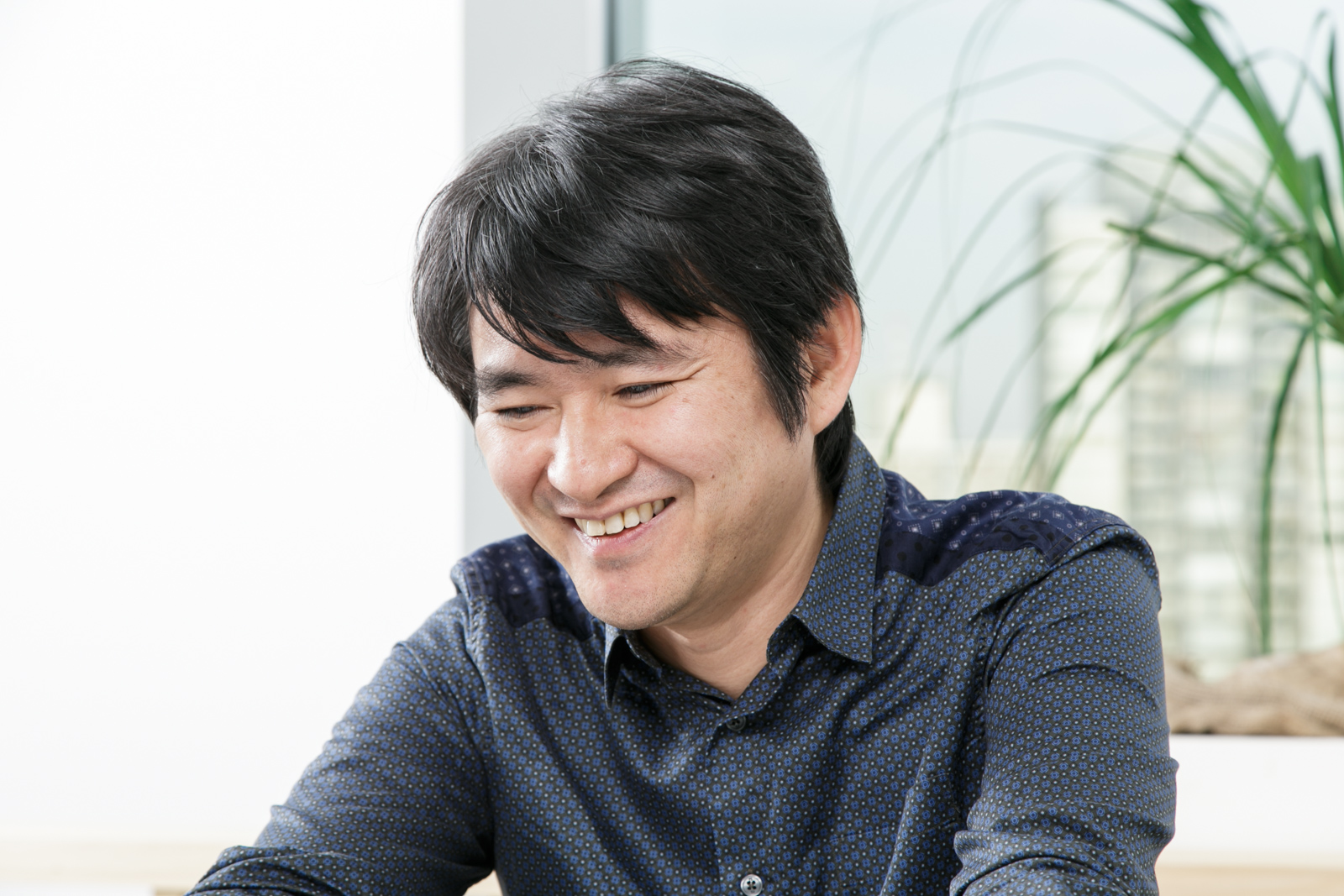 |
But, if you can’t discover the “core” of a new experience, the game will have to be redesigned even if you embellish it. If you play with just the primitive sounds and images, and you confirm even the slightest interest there, you can finally ask the designer to begin embellishing. Repeating this process will get closer to the potential of this approach.
— You say this lightly, but sounds like overwhelming, tedious work .
Mizuguchi:
But then again, we tried it for a while, and we couldn’t reach the point of “a game that feels as good as performing music” at all. It was becoming more and more painful … So with desperation, we decided to analyze the “wants” in music.
Then, I suddenly thought of a club’s DJ. DJ’s look relaxed and comfortable, and the people dancing do, too, right? I thought about what makes this comfortable loop structure. Actually, this examination led to the idea of the light cube that frequently appears in “Rez.”
— That’s the cube that appears at every important point of Rez, right? If you hit that, the music and image switches. That’s important? If anything, I thought, ”I wonder if this is necessary” the first time I played.
Mizuguchi:
In fact, that became the decisive breakthrough.
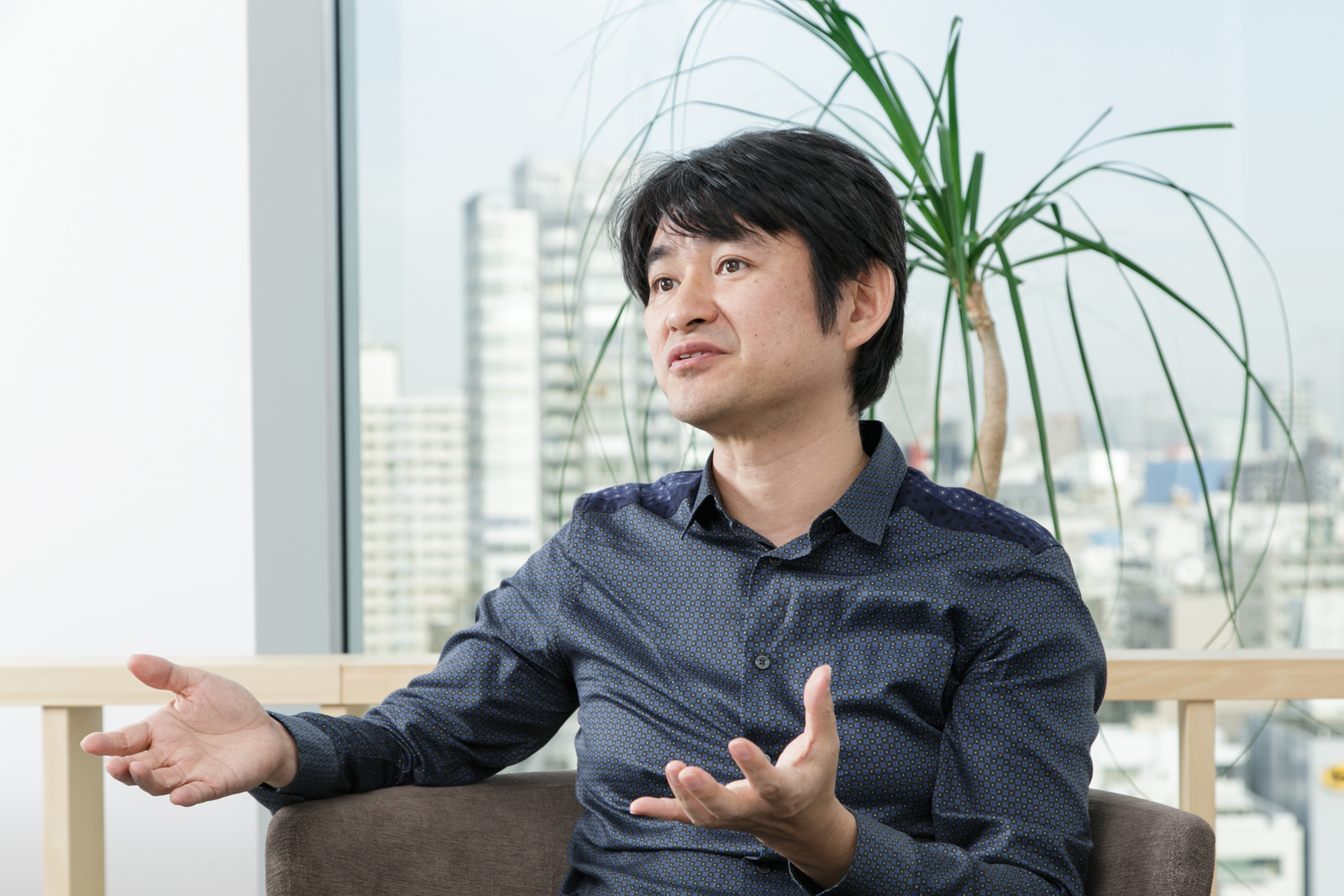 |
I tried adding to the game, the idea of the cube of light warping the moment it’s hit eight times and the backing track changing. It’s the same thing a DJ does. The moment when this backing track change coincided with the orchestra-like sound from shooting enemies, the experience of “Rez” suddenly began to move. Rather than repetition of one thing, one way or another, by multiplication, this wave grew to the game, and was followed with “Ok, let’s try to adapt music to this prototype.”
That’s when we earnestly began creating the music of “Rez”.
— I thought it might have just been something like, you meditated with a musician like Ken Ishii[*], who was popular at the time, and created the game accordingly. But after exploring the enjoyment of “operation” like a researcher, the music was added at the end.
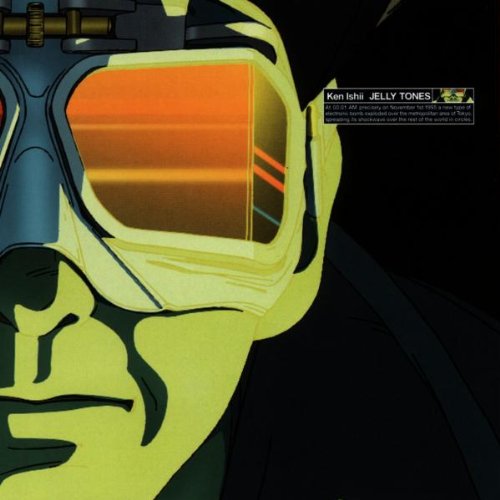
(Image from Amazon)
Mizuguchi:
At first, it was repeated observation and demonstration experiments. I often held experience workshops, too.
We all went to Sado Island and experienced Kodo to think about, “what is satisfying about hitting a taiko drum?” Or we would go to a club and observe, “why do the people on the dance floor all cheer here?” I just fervently pondered. And once the light bulb went off, a demonstration experiment with everyone— a repeat of that.
— Even so, I think this obsessiveness in the handling of sensation is reflected in Mr. Mizuguchi’s origins at the arcade. Or maybe it’s in the music videos.
Mizuguchi:
I was aiming for something that could be played over and over again, no doubt. I think it’s something like, enjoyable music. Games that aren’t played a second time once the end is reached are the most unfortunate.
What is expressed in Rez’s story?
— So now we know “Rez” was built up from a simple place, but this world with an exposed wire frame, was it an option within the resolution at that time?
Mizuguchi:
I often used expressions like, “experiences from first dimension to second dimension to third dimension and beyond,” and I wanted to create experiences that was like starting from zero to infinite. But sales would always say, “Let’s make it more exciting from the opening” (laughs).
As for the story, I discussed with the team members and we became enthusiastic over “cyberspace could be good.” Combining it with the music, the pixels would turn into vector monitor[*]-like lines, and finally three-dimensional. We thought that would be cool.
*Vector Monitor
A method of composing an image by directly following the shape of the figure using electron beams, such as lasers of a cathode-ray tube.
— I see. But there is obviously some story behind the method to this development. For example, the last stage in the game is reminiscent of something like the history of life evolution.
Mizuguchi:
Actually, the theme of “Rez” is “Conception.”
The official story is “hackers exterminate viruses in cerebral space, purify the mother computer in the end and reactivate to its normal state to unite.” But, on the back side, it’s something like, “everyone is a sperm and an egg” (laughs).
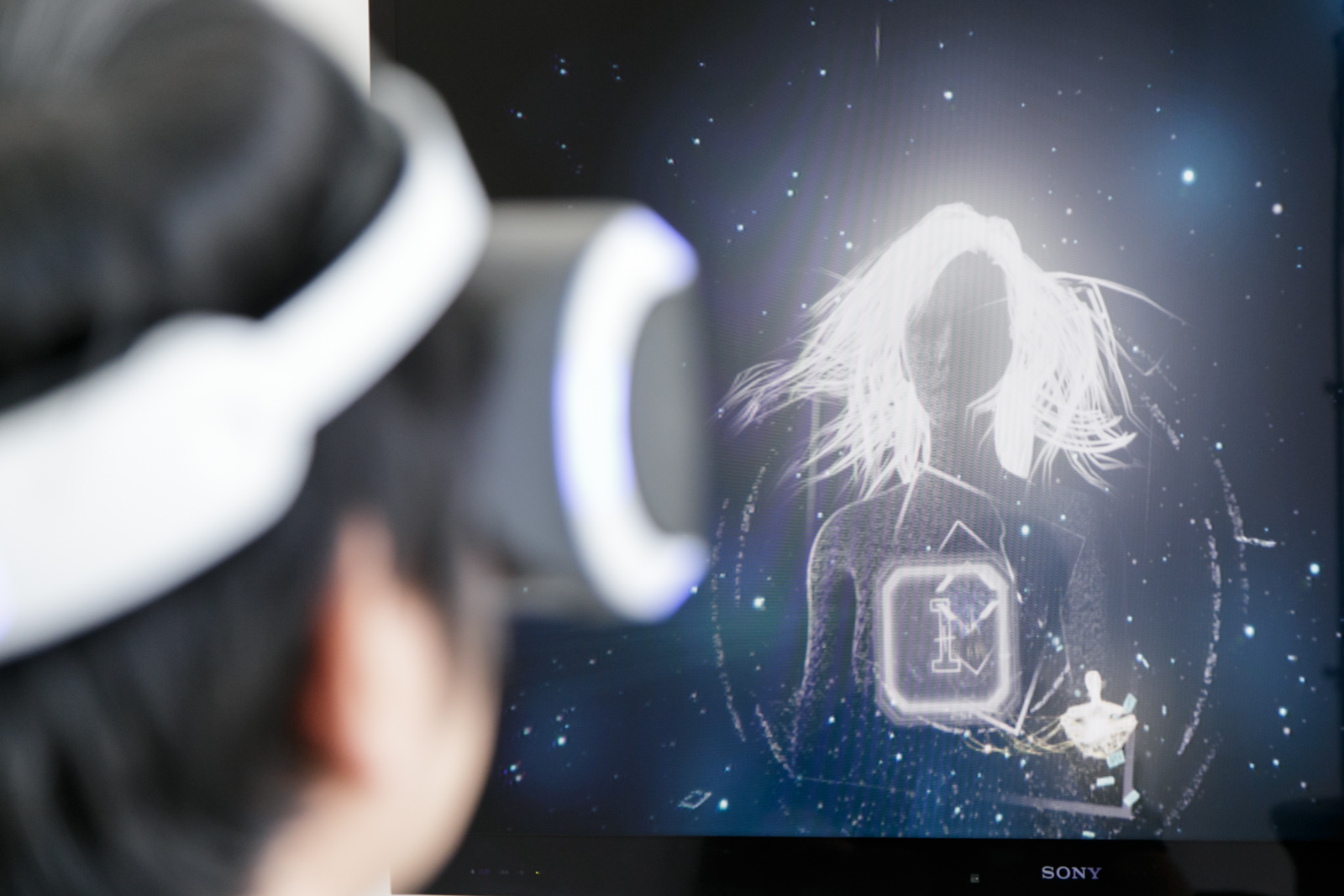 |
What was released from the father’s body traveled towards the mother’s womb, broke the barrier, united, conceived, and we were born. Both men and women. Even after overcoming great obstacles and discrimination, the last, toughest and strongest thing to welcome is us, is it not?
No one remembers the story up to conception, but it probably remains in our instincts. That’s what’s condensed in the last scene of “Area X.”
— What is the reason for trying to portray such a story?
Mizuguchi:
(Silence for a while)
…… The good thing about video games is that you want to experience it over and over again, right?
The more it’s repeated, if it’s able to summon that story from our human instincts… no, on a DNA level, I thought it might begin to grasp at some message of a deeper nature.
— It seems frequent by home video game designers after Play Station to incorporate philosophical messages of that nature.
Mizuguchi:
A long time ago, I saw a painting by Kandinsky[*] called “Moscow 1” up close. I couldn’t move for about 30 minutes. The “sound” of one day, from morning to sunset that he experienced in the city of Moscow 100 years ago, I could feel it from this one image.
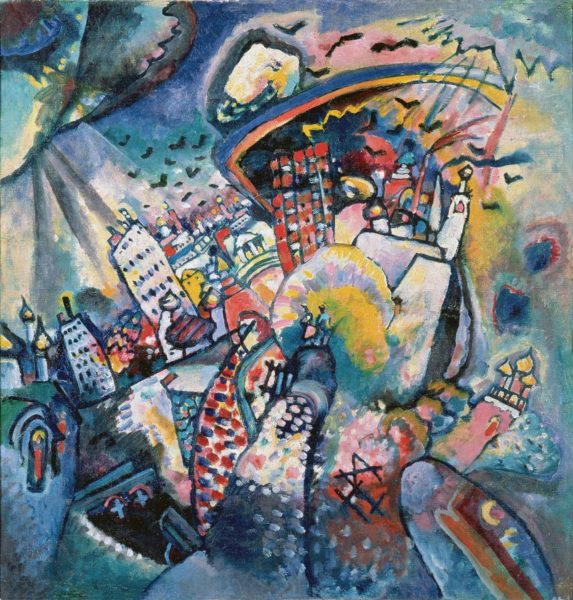
(Image from Wassily Kandinsky.net)
At the time, the artists of Bauhaus[*] were basically expressing “synesthesia.” I thought it would be a new experience if I could unite the synesthetic experience and storytelling.
*Bauhaus
Founded in 1919 in Weimar, Germany. A school that provided comprehensive education on arts and architecture, including crafts, photography and design.
—I see. By the way, what kind of story is “Area X” then?
Mizuguchi:
The story of “Area X” is “Birth.” If “Rez” is a story of “conception,” up to the moment when sperm and egg unite, then “Area X” is a story that something new will be “born.”
—What! So the image of the giant woman in the end is not a mother, but a child soon to be born?
Mizuguchi:
Well, from a human point of view … yes.
But, the symbol in this story is “Technological Singularity.” [*] Actually, the woman who appears in the end has two versions, where both the music and singing are different. One is a woman who encompasses male strength and the other is a woman with feminine beauty. A human’s sex is determined by a combination of X and Y on a DNA level, but it occurs during the process.
There was no option of a man appearing at the end … I wonder why … … (wry laugh). Well, we are all born from women, maybe it was something like that.
*Technological Singularity
The point when artificial intelligence will surpass human ability. Although it became well known in 2005 by advocate and inventor Ray Kurzweil, mathematician Verner Vinge first introduced the theory in 1993. Ray Kurzweil reasons in his book, “The Singularity Is Near: When Humans Transcend Biology (2005),” that by 2029, general-purpose artificial intelligence (AGI) will be wiser than humans for the first time in history.
